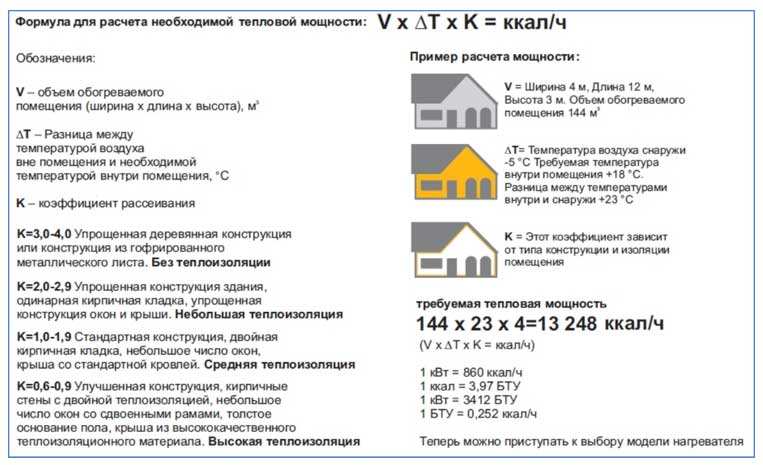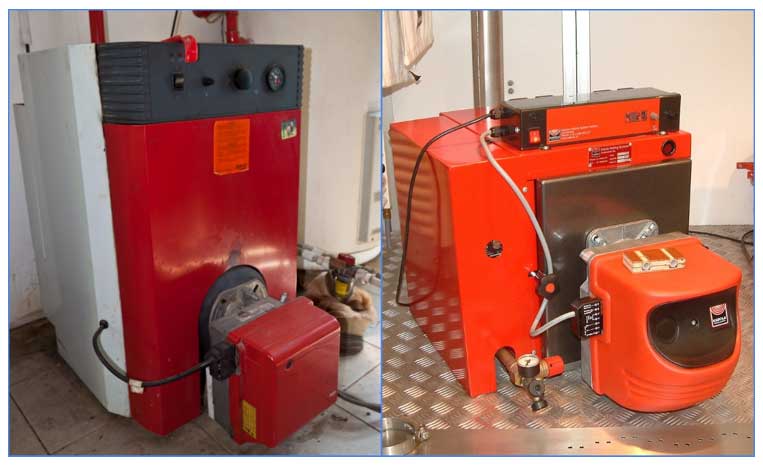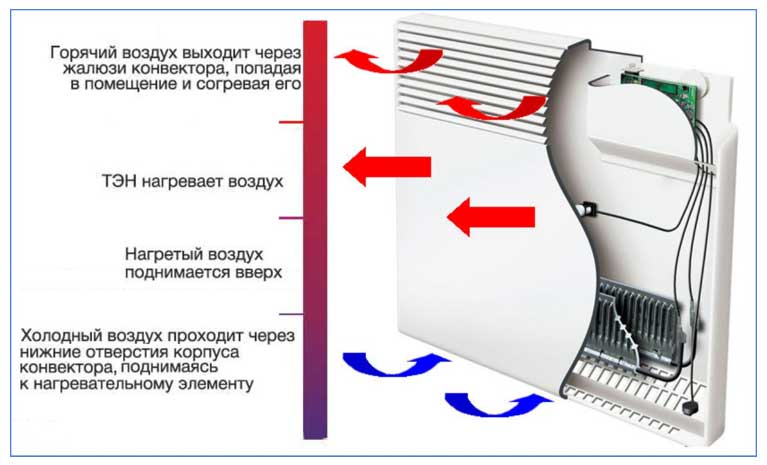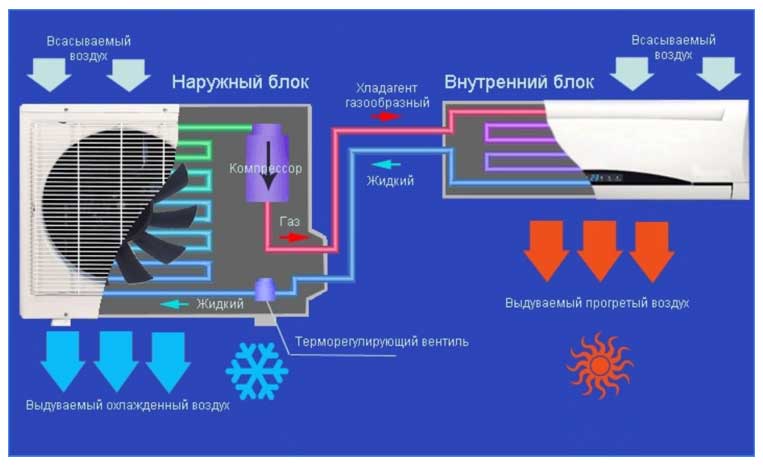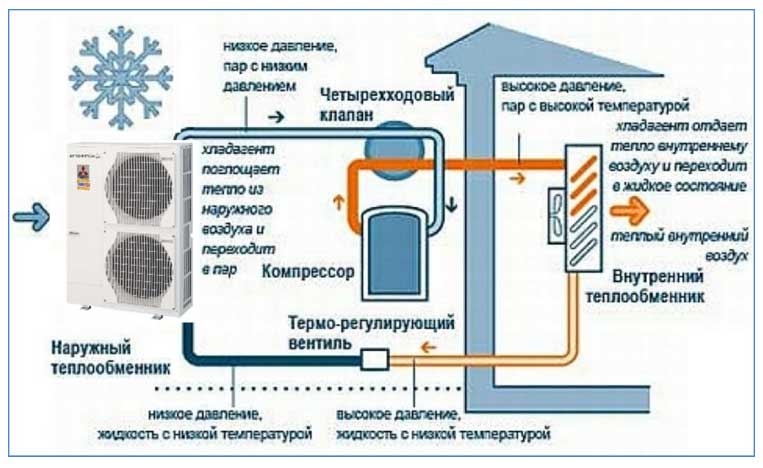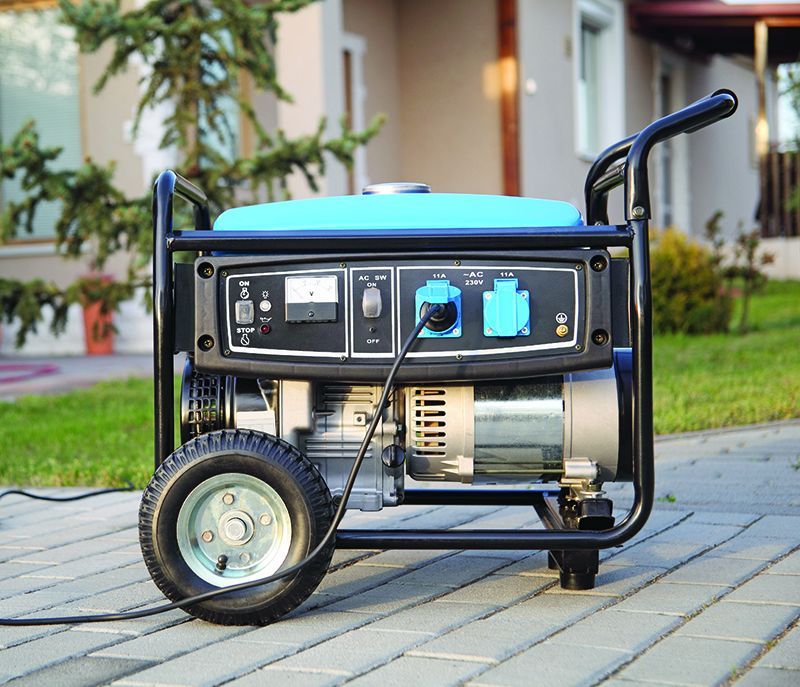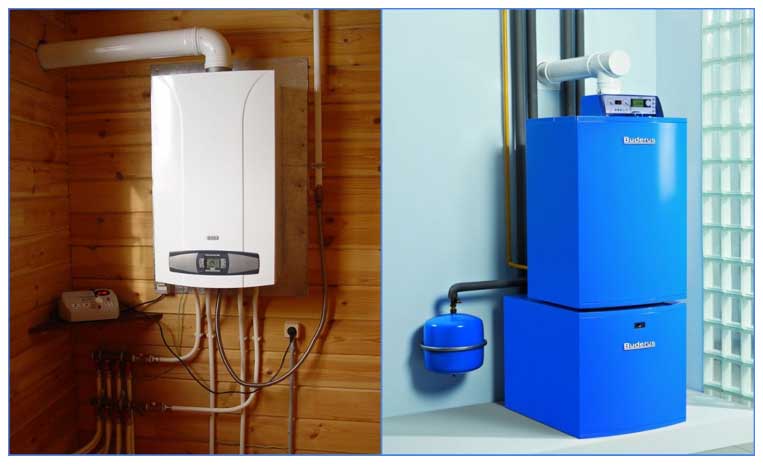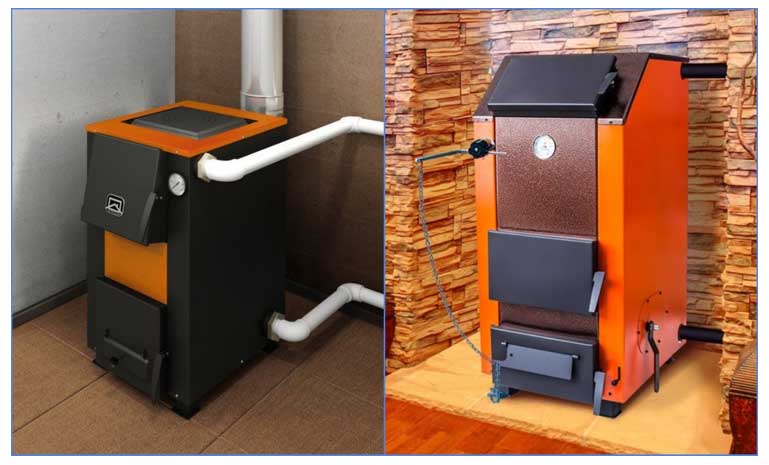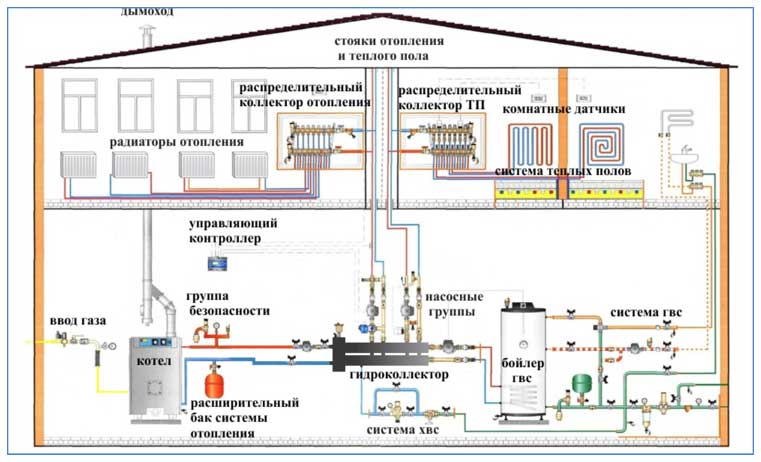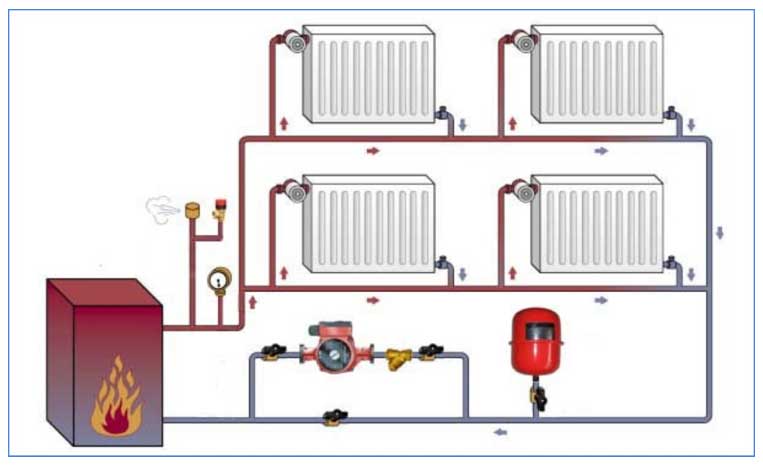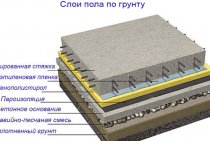Selection of a boiler for autonomous heating by power
In the passport data for the boiler, its rated power must be indicated, sometimes the manufacturer gives the area of \u200b\u200bthe premises in square meters that this boiler can heat. For average calculations, the consumption of 1 kW of the thermal power of the unit is taken for heating 10 square meters of a living space with a ceiling height of 2.5 - 2.7 m. If the height is greater, a correction factor is entered, for example, the power is multiplied by 1.23 at a distance from the floor to the ceiling 3.2 m.
Also, the calculations take into account the climatic zone in which the house is located, it is included in the formulas in the form of a correction factor and ranges from 0.7 for the southern regions to 2 for housing located in the northern regions. If a double-circuit boiler is used for heating water, its rated power is increased by 20 - 25%.
To determine the power of a heat generator, SNiP 2.04.07-86 is sometimes used, according to which for low-rise buildings, if the external average temperature is -25 ° C, heat consumption is considered at the rate of 173 - 177 W / m2, and in apartments of high-rise buildings the standard is taken equal to 97 - 101 W/m2.
Summing up, it should be noted that for approximate accelerated calculations, taking into account various factors (hot water supply, high ceilings, cold climate), the boiler is usually chosen with an average power, which should be about 1.5 kW per 10 m2 of the room.
Rice. 16 Example of heat output calculation
Rules for designing autonomous eco-houses
In the detailed design of buildings (orientation, insolation, etc.)
energy requirements should also be taken into account, if possible. Autonomous houses
must be designed very carefully, and this principle must be respected in
the smallest details.
Here are the basic rules that should always be followed: * build with climate in mind and study natural conditions;
* a project that does not take into account energy conservation, in most cases does not have
success and always uneconomical;
* good insolation of the entire building reduces its energy
needs;
* the R value for walls and roofs must be at least 5;
* use triple glazing whenever possible;
* position openings and solar collectors on the south side and correctly
orient the building
* avoid shading the southern facade of the building;
* take into account the relationship of aesthetic and technical aspects when designing
solar collectors and heat accumulators;
* take into account that technically and structurally the repeated use of energy
always finds use in the house (waste water, lighting, etc.);
* provide for protection of the house from the cold wind (trees, slopes, thermal
buffer zones, etc.);
* in windy areas to widely use the power of wind turbines;
* carefully calculate the optimal ratio between the volume of the building and the external
surface (the maximum possible volume with the smallest surface);
* provide for the design of a thermal buffer zone (i.e. double doors,
covered terraces, etc.);
* use the rare physical phenomenon of exothermy (heat transfer);
* use the thermal properties of the building accumulators in terms of
the optimal tank solution to compensate for day (night) heat losses and
meet seasonal thermal energy requirements;
* take into account the optimal ratio of comfortable, autonomous and external energies;
* reduce heat loss through windows by increasing the value of R (window during the day
provides us with less heat than it loses at night. If windows
insulate at night, positive heat balance can be obtained through windows
south facade of the house).Windows are also used as solar collectors and
cooling devices. Vertical, south-facing glazing
especially effective for collecting solar heat in winter. Use curtains or
blinds made of heat-insulating material to minimize night
heat loss during the winter and avoid excessive heating in spring, summer and
autumn.
Continuation:
General view of the autonomous eco-house
Layout of an autonomous eco-house
Option 2. Autonomous solar power plant for the home or wind turbine
Another way to get autonomous electricity is solutions in the field of alternative energy. They work with the energy of natural sources such as wind, sun or water.
There are many options for industrial production of electricity from renewable sources, including hydroelectric power plants and even biogas combustion plants.
In the private sector, solar panels and wind turbines are most widely used.
- Solar panels generate electricity from photovoltaic cells - solar panels that are installed on the roof of a cottage or on hills.
- Wind turbines with a vertical or horizontal axis convert wind energy into electricity. In climate conditions, they do not work as efficiently, and their installation makes sense in places where there is a constant wind.

In addition to direct devices that convert the energy of nature into electricity, an autonomous mini-power plant also includes an inverter for converting direct current into alternating current.
It is also possible to connect a battery to the system, which will accumulate electricity during the period of peak activity of the energy source. In this case, the system becomes completely autonomous and does not involve the sale of electricity to the state.
Saving potential of a solar power plant
Solar batteries with an area of 10 m2 are capable of generating about 100-150 kWh of electricity per month, which means that for the needs of a family of 3-4 people, an autonomous solar power plant with a solar cell area of 20 m2 or more is needed.
Taking into account the current “feed-in tariff” program, a 10 kW network mini-power plant (turnkey cost is about $10 thousand, area is about 60 m²) will pay off in about 8-10 years. After that, the equipment will work at a profit for at least 15-20 years.
What is a "green tariff" and how to connect it
In order to become a member of the state program "Green Tariff" you need to have an installed solar mini-power plant (or wind generator).
It is also necessary to connect a two-way electric meter to the power grid, which will keep records of the received and sold electricity.
The equipment will need to be registered with local authorities, and the meter will need to be verified and sealed in accordance with the requirements of the electricity supplier.
In order to start selling electricity, the state will have to open a current account in hryvnia to transfer funds and conclude an agreement with an energy company.

The cost of electricity that can be sold to the state until the end of 2019 is 0.183 €/kWh. Over time, the tariff will decrease: from January 1, 2020 it will be 0.164 € / kWh, and from January 1, 2024 - 0.146 € / kWh.
Registration of permits for the arrangement of autonomous heating
To install an autonomous heating system in a country house, you will have to contact the village or city administration at the place of residence, since the installation of such a system is a restructuring or redevelopment of the premises, the following documents will be needed:
- An application of the approved form, which is stipulated in the Government Decree of April 25, 2005 No. 266.
- Certificate of ownership with accompanying documents: state registration, donation agreements or transfer of housing ownership, notarized inheritance rights.
- With equity participation, confirmation of ownership of the property from all owners and their consent to the installation of the system (signature of all residents in the application) will be required.
- A photocopy of the technical passport of the premises.
- Confirmation of the status of housing by architectural bodies and organizations involved in the protection of monuments, whether it is of architectural, historical or cultural value.
- A project for a device or redevelopment, consisting of a plan for placing a gas pipeline and installing a boiler.
- When installing a powerful electric boiler (if the value exceeds 30 kW), you will need a copy of his passport confirming the maximum power, an electricity supply contract.
- A home remodeling project (relocation or dismantling of internal partitions, walls, door and window openings), if it occurs during the installation of equipment. It is compiled by the design organization, the documents contain basic information on the installed system, technical calculations. Also, design solutions are coordinated with the fire department, the sanitary and epidemiological station, and gas workers.
- Technical conditions for connecting the gas main (issued by gas distribution state organizations or private owners of fuel and communications), ventilation devices in the room with the boiler.
This package of documents is submitted to the interdepartmental commission responsible for the operation of the housing stock and located in the administration, and a response should be expected in about 45 days.
After carrying out work on connecting and installing networks by the relevant services, an acceptance certificate is drawn up, a copy of it is submitted to the real estate registration service.
Rice. 19 Installed oil boiler
solar architecture
The design of the dwelling should be carried out on the basis of strict accounting
natural and climatic features of the region using the achievements
traditional building. The foundations of this approach were laid by F.L.
Wright.
A steep slope of the roof is oriented to the south, a longer, gentler one - to the north, because. v
In this case, it resists snow and wind loads better. Basement and
basement floors, attics are heavily insulated, the entrance to the house is organized through the vestibule.
The main openings, protected by shutters, are oriented to the south. Space-planning
the solutions of these houses serve as the basis for the design of solar houses in cold weather.
climate. Thus, even in a traditional dwelling, natural and climatic
conditions significantly change the appearance of the house. Climate is especially important
differentiation in the design of solar houses.
Specialists in terms of the level of use of environmental resources are distinguished
several types of residential buildings: * energy efficient building, the heat loss of which is reduced to
minimum due to the choice of the optimal space-planning solution and enhanced
thermal insulation;
* energy efficient building with enhanced absorption of solar radiation,
but without devices for accumulating the received heat;
* a building with minimal energy loss, with special absorption systems,
heat distribution and storage (solar house).
Autonomous heating system principle of operation and main components
Any autonomous heating system includes the following main components:
Heat generator. It is a device that converts the electrical or energy of the burning fuel into thermal energy, while in the heat generator, thermal energy is simultaneously transferred to the coolant. Two main forms of the environment are used as a heat carrier - air masses and liquid.Most often, purified distilled water is used in heating systems, which has the highest heat capacity coefficient, that is, the ability to transfer and store energy, all other liquids, including non-freezing antifreezes, are significantly inferior to water in this indicator.
To convert the fuel into thermal energy and transfer it to the carrier, the process of its combustion in heating boilers takes place; if electricity is used, the heat-carrying medium is heated by heating the material with a high electrical resistance to alternating current and its mutual heat exchange with the working fluid.
Heat transfer line.
Polymer pipes, due to their flexibility and elasticity, made it possible to install multi-circuit warm floors with water heating in buildings, which was impossible to do with metal pipelines.
Heat exchange devices. The coolant from the boiler through the pipes enters the heat exchangers, which in most cases are radiators, the liquid passes through them and gives off heat to the air due to the large area of the heat exchanger housing. To increase or decrease heat output, it is possible to change the configuration of the batteries by adding or removing individual sections; the material for the manufacture of radiators is steel or aluminum, which have good heat transfer (high thermal conductivity).
Rice. 4 Air convector - principle of operation
The shape of the house and the level of thermal insulation
The first step in the design of a solar house is the selection of the optimal
building shape. As a rule, a compact, close to square shape is recommended.
plan with a minimum perimeter of the outer walls. The indicator of compactness is
coefficient equal to the ratio of the area of the outer walls to the internal volume of the building.
To reduce the surface of the outer walls, cylindrical,
hemispherical and other non-traditional shapes. To reduce power consumption
many standards for the design of building envelopes are being revised,
their heat-insulating properties are enhanced through the use of more advanced
insulation materials, elimination of infiltration and blowing through door and
window openings, triple glazing applications in cold areas. Big
the effect is produced by the differentiation of premises according to energy needs and mode
operation. Low-heated premises (wardrobes, pantries, bathrooms, garages and
etc.) is recommended to be placed along the northern wall as buffer elements.
Energy and engineering concept of an autonomous house

The house is not connected to power grids and external sources of heat. Everything is made on site.
Energy is generated by a solar power plant with a capacity of 126.5 kW, it occupies the entire facade and roof of the building. Thin-film photovoltaic modules are installed on the facade. The panels are ineffective, but they have no glare and are multi-colored, that is, they are ideally suited as facade materials. Highly efficient single-crystal modules are installed on the roof of the autonomous house.
Locally produced electricity covers all the needs of the home of the future. "Excess" electricity is sent for short-term storage in lithium-ion (lithium-iron-phosphate) batteries with a capacity of 192 kW. h. The "maximum surplus" of electricity that occurs in the summer season goes to long-term storage. To do this, hydrogen is produced by electrolysis, which is stored in special tanks with a total volume of 120 m3 under pressure up to 30 atm. (on the picture).

Thermal energy is produced by a 28 kW geothermal heat pump (two probes 338 m deep each). In the basement there are gigantic heat storage tanks (2 x 125 m3), insulated with 200 mm thick insulation.Hot water for domestic use is produced in the cleanest way - flowing, using fresh water modules.
The house has a central ventilation unit with an efficiency of 83% with heat recovery. For frost protection, heat is supplied from the room in which the batteries are installed.
In the house, you cannot tilt (slightly open) the windows, putting them in “ventilation mode”, you can only open them completely. This was done in order to minimize energy losses - so that residents do not “accidentally” leave open windows in winter.
When “current” energy, that is, produced by a solar power plant, produced by batteries and heat storage devices, is not enough to provide residents, hydrogen is included in the balance. The fuel cell produces electricity and heat. According to calculations, the need for the use of hydrogen with the given parameters of an autonomous house and the configuration of engineering systems may occur only for 20-30 days a year, mainly in the winter months.
The apartments are fully finished, furnished and equipped with the most modern (energy efficient) appliances and LED lighting.
Residents living in the house do not pay for electricity and heat if they stay within the established "budget", which averages 2200 kW. h per year. Each apartment has a monitor showing how much energy is consumed. The first experience of the residents shows that so far they fit into this “social norm”.
How much does this self-contained home of the future cost? 5.3 million Swiss francs - the standard cost of a building of similar size in Switzerland (recall that the premises are fully equipped) + 0.8 million - additional costs for "special" engineering systems. Additional settlement costs are amortized by increased rent (but since residents do not pay "communal", their total rent payments are at the local average). These figures do not include the "hydrogen part" - the electrolyser, hydrogen tanks and fuel cells. They were provided for this facility as part of R&D and their cost is not indicated. A source
Air heating with convectors
For air heating, electric convectors are usually used, the built-in fan of which supplies air to the heating elements, after which it enters the room. The air can be heated by air conditioners operating in heating mode, and ordinary cheap electric heaters without open-coil fans, or oil heaters, where the heating element is immersed in the coolant. The latest technology is the use of energy-saving air-to-air heat pumps for heating, the thermal energy obtained as a result of their operation is transferred to air masses and distributed throughout the entire area of \u200b\u200bthe room due to built-in fans.
Heating of premises with heated air is not a very popular method among the consumer and has the following features:
- All options for air heating allow you to heat the room in a short time, unlike water heating, which requires significant time intervals to start the heat supply.
- Electric convectors with an open spiral burn oxygen - this worsens indoor air quality and can cause headaches.
- If one convector is used for heating several rooms, you will have to install a bulky air duct system and hang it from the ceiling.
Rice. 5 Heating with air conditioners
- In addition to heating, a high-tech heat generator (air conditioner) is able to perform the functions of humidifying, filtering or cooling air in the warm season.
- The heating installation and ventilation ducts are not threatened by defrosting during the cold season, as well as leakage of the coolant in the system, which is air.
- Air heating is easy to implement in any room of large or small area; in the simplest case, it is enough to connect the convector to a socket to receive heat.
In addition to small heat generators operating on electricity, stationary large-sized heat generators operating on gas or liquid fuel are used for air heating, their main components are (Fig. 7):
- Gas burner placed in a large volume tank (housing).
- A combustion chamber in which gas is burned and its thermal energy is transferred to air.
- A system of fans providing air exchange and supply of heated air to the air ducts.
- Air ducts that direct the flow to different rooms.
- Electronic system of automatic control and monitoring with setting the operating mode and temperature parameters of the convector.
Rice. 6 Principle of heating with heat pumps
Two ways of autonomous power supply at home
You can install a mini-power plant for a private house at any stage of the construction and operation of the cottage.
Option 1. Liquid fuel or gas power generator
Sometimes a house begins to be built even before the site is connected to the power supply. And in this case, the generator is a universal solution for supplying autonomous electricity.
A mini-power plant will also come in handy for backup power supply at home in case of a power outage.
In the private sector, the following devices are most often used:
Portable gasoline generators
Power up to 5-8 kW are in the greatest demand. They are able to provide autonomous power supply at home for a short time and are suitable for the role of a backup mini-power plant in case of force majeure.
The units are usually a metal frame with a 4-stroke engine feeding an alternator. The motor resource of popular models of gasoline generators is usually limited to 1500-2000 hours.
Devices allow you to connect 2-4 consumers of single-phase current at 220 V. There are also 3-phase generators at 380 V on sale. Some models are equipped with automatic start.

Diesel and gas mini power plants
They have occupied a niche in the market of more expensive and powerful power plants. They are bought not for situational, but for long-term autonomous power supply at home. The power of popular models ranges from 5-6 to 30 kW, and the motor resource is many times greater than the capabilities of portable gasoline generators.
Many gas and diesel mini power plants are equipped with an all-weather metal casing, which allows them to be permanently installed outdoors.
Moreover, stationary gas generators can be connected not only to a gas cylinder or an underground gas tank, but also to a gas pipeline, which allows you not to worry about their refueling.
Such units are more expensive than diesel models, but they are quieter and use less oil and components.

Power plant for home: choice of power generator
The power of the generator for autonomous power supply at home is selected, focusing on the total power of the equipment that needs to be reserved.
At the same time, at least a 20% margin is laid in case of peak loads. Ideally, they sum up not the working, but the starting power of the devices, which for most equipment exceeds the standard power consumption.
Conventionally, 2 types of power generators can be recommended for autonomous power supply at home.
Single-phase mini-power plants with a capacity of 3-5 kW are able to provide backup power supply to all critical equipment
For serious power tools and powerful equipment (such as an electric stove), you will need a single-phase or three-phase generator with a power of 5-7 kW or more. The cost of such devices starts from 10-15 thousand hryvnia.
Do-it-yourself heating system installation steps
Installing a simple heating system in a house with your own hands without collector wiring and laying underfloor heating is a task that many homeowners can do with a simple construction and plumbing tool. For efficient and high-quality work, you will also need knowledge of the boiler installation scheme (instruction to help), the technology for installing pipelines of various types, special skills in soldering or welding pipes if a polypropylene or steel pipeline is selected. Do-it-yourself installation of an autonomous heating system in a private house or apartment from a to z is carried out in stages in the following order:
- They independently draw up or order a heating scheme in an architectural organization, taking into account the design features of their home, building a well for connecting to a gas pipeline.
- Determine the type of fuel and boiler that will be used for space heating, its configuration (double-circuit or single-circuit).
- They choose the material of the pipes, if they are planned to be hidden under the floor when leading to heating radiators, they purchase products made of cross-linked PEX polyethylene of a suitable diameter. Their indisputable advantage is flexibility, the ability to interconnect and connect to heating equipment using compression fittings that do not require special crimping or soldering plumbing tools.
- The type of heat exchangers is selected, calculating the number of radiators and the required battery power in accordance with the areas of heated premises and the optimum temperature in the premises, the number of sections is calculated manually or using calculators.
- They are determined with the connection scheme of their batteries, it can be single-pipe or two-pipe, the best results are shown by the associated two-pipe wiring, which provides the same heating temperature for all radiators connected to the line.
Rice. 17 Gas boiler for independent heating - installation option
They proceed with the installation of the system, installing it on the floor in the basement and hanging the boiler on the wall, after which through holes are drilled in the walls and the pipeline is installed, if the heating pipes are located in the floor, strobes are cut in the screed into which the pipe connection is laid.
Strobes are also made in the walls, if the pipeline is allowed on the surface and they want to hide it to increase the aesthetic appearance.
- Radiators are hung on the walls, to reduce heat losses, a foil film is placed behind them to reflect infrared radiation, and a heating pipeline is connected to them.
- The system is filled with water and checked for leaks; for this, the liquid is supplied under pressure that is 1.5–2 times higher than the working one (pressure test) and the system is left in this position from 30 minutes to 24 hours.
- They turn on the boiler at a low temperature and check the heating of all radiators, remove air plugs that interfere with circulation and heating with the help of the Mayevsky cranes built into the batteries. After the entire system has been vented, the boiler is turned on at full power and the operation of the system is sequentially checked under various operating modes, changing the feed rate on the circulation electric pump.
- The final step is to balance the system in order to achieve the same heating temperature for all radiators; for this, thermostats are usually built into them before installation, and the user can only check the correctness of their operation with a thermometer.
Fig 18 Solid fuel boiler with a capacity of 20 kW in the basement
Pros and cons of autonomous heating
Autonomous heating is primarily understood as independence from various factors, natural conditions and organizations that are to some extent associated with the sale of thermal services or heating materials in a given area. The advantages of individual heating are:
- Choosing the heating equipment and type of fuel that suits your financial capabilities and ease of use.
- Ability to set the beginning and end of the heating season at your discretion.
- Adjustment of a comfortable temperature for yourself not only in the whole house, but also in individual rooms.
- When designing, the advantage is that it is possible to place heating radiators at your discretion, remove or put on them one or more than one section to optimize heat transfer. You can lay underfloor heating, choose within a wide range the power of the boiler and the parameters of the entire heating system, regardless of the characteristics of the external heat main, on the official connection to which some restrictions are imposed.
- In the absence of a long time in the house, you can completely turn off the heating or set it to operate in economy mode.
- The use of double-circuit systems in an individual house allows not only to heat buildings, but also to heat cold water to a high temperature for use in everyday life and personal hygiene.
Rice. 2 Option scheme for heating and hot water supply of hot water in a private house
The use of solid or liquid fuels, which are stored in certain quantities, make the heating system completely independent of external communications - gas pipelines, heating mains, and allows heating the house without reference to emergency situations on engineering routes outside it.
Despite the numerous advantages, autonomous heating has quite significant disadvantages, the main ones are:
- The operation, maintenance and control of an autonomous heating system takes a lot of free time and requires some physical effort when using solid fuels.
- The main disadvantage of individual heating is the high cost of purchasing and installing equipment: a boiler, heat exchange radiators, collector interchanges and pipeline systems for underfloor heating, circulation electric pumps, plumbing fittings (air vents, check valves, shut-off valve and ball valves), control automation.
- After installing the system, fuel costs also take a significant part of the budget, many homeowners cannot afford to pay for the energy consumption of an electric boiler.
- During installation, additional costs will cause a change in the configuration of walls, partitions and floors for laying pipelines, the installation of screeds for underfloor heating.
- When using natural gas from the central pipeline as a fuel, permission from the relevant authorities is required, while obtaining it is a long-term, complex and tedious procedure that requires the investment of significant sums of money.
- Financial resources will also be needed to ensure contractual obligations with organizations involved in the maintenance and repair of installed equipment, and service center specialists.
Rice. 3 The principle of operation of a closed heating system
